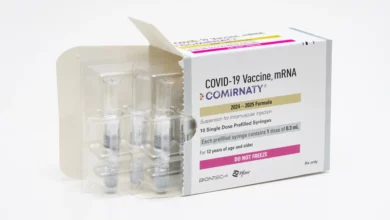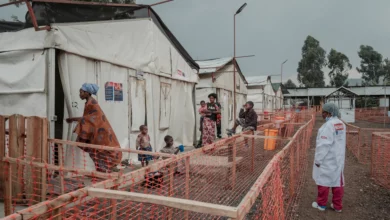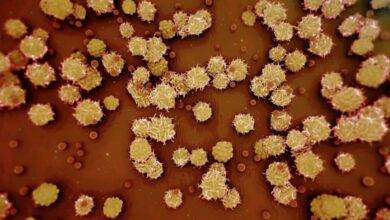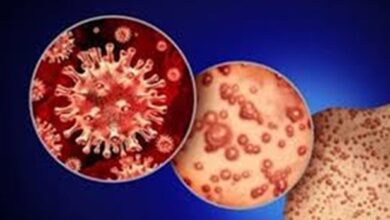
(CNN) – A hallmark of the ongoing monkeypox outbreak is that most cases have been linked to sexual activity, and this has prompted some debate around whether to describe the illness as a sexually transmitted disease.
“Many infectious diseases, although we will classify them in one manner of transmission, have multiple mechanisms of transmission,” said Dr. Amesh Adalja, a senior scholar at the Johns Hopkins Center for Health Security at Johns Hopkins Bloomberg School of Public Health. Monkeypox may spread sexually, he noted, but it is clearly spreading through non-sexual close contact, as well.
“I don’t think we have enough information at this point to completely classify it. I think there’s some suggestions, but there’s more study that needs to be done,” Adalja said.
“There are other infections — for example, syphilis — that spread through other ways other than sexual transmission,” he said. “Zika virus is a mosquito-borne illness, but it can also be spread sexually. The question to me is more about making sure we’re clear on what’s going on from a physiological standpoint before you would make that type of claim.”
Some experts argue that labeling monkeypox as an STD could be not only misleading but potentially harmful for public health.
“A negative about suggesting that monkeypox is an STD is that people who are not having sex think immediately, ‘OK, I’m not going to get it,’ ” said Dr. Saju Mathew, an Atlanta-based primary care physician and public health specialist.
“What a lot of people will think is it’s like herpes or gonorrhea or chlamydia — meaning you have to have sex to get it. That’s not true. So that is why it’s dangerous to suggest that it is only exclusively transmitted via sex. That’s misinformation,” he said. “It is transmitted via sex in a majority of cases, but it’s not exclusively transmitted via intimate contact. You can also get it through non-intimate contact.”
David Harvey, executive director of the National Coalition of STD Directors, said he and his colleagues refer to monkeypox as a “sexually associated” infection for now.
“With the data that is available now, we know that the primary mode of transmission is sexually associated — contact that is of a sexual nature. Technically, a sexually transmitted infection is defined as an exchange of genital fluid that have a virus or bacteria that is associated with a sexually transmitted infection,” Harvey said. “We need the science that shows definitively that this is an infection that can be passed by semen or genital fluids, and the science on that is not quite clear yet, which is why we’re calling this sexually associated.”
What makes an STD
STDs, also known as sexually transmitted infections or STIs, are infections that are passed from one person to another through sexual contact such as vaginal, oral or anal sex. In some cases, these infections also can spread through skin-to-skin intimate contact, as with herpes and HPV.
The long history of STDs dates to archaic times. Some studies suggest that migrations of modern human ancestors can be associated with HPV, types of herpes and other sexually transmitted diseases.
In modern times, a study out of Nigeria was among the first recent reports to describe the possible sexual transmission of monkeypox. That country experienced a large outbreak of monkeypox in humans in September 2017, and the study about it was published in the journal PLOS One in 2019. Previously, human-to-human transmission was thought to primarily occur by means of saliva or respiratory droplets or direct contact with the pus or crust of lesions.
“There is no formal process to label an infection as an STI or STD,” Kristen Nordlund, a spokesperson for the US Centers for Disease Control and Prevention, wrote in an email to CNN on Monday. “Experts generally determine, scientifically, if a pathogen can be transmitted through sex, in which case it’s called ‘sexually transmissible.’ And how frequently the infection is referred to as an STI relates to the proportion of transmissions accounted for by sex vs some other route — but there is no ‘rubric’ that is used to guide this determination.”
She said monkeypox can be described more accurately as “sexually transmissible,” as sex is one of the ways the virus can spread — but not the only way.
“Sex is a human behavior. If stigma wasn’t associated with infections transmitted through sex, there would be less concern of implications for saying monkeypox is an STI for people who are more heavily impacted,” Nordlund wrote. “It’s also important to look at this question globally — and keep in mind the implications for this label vary depending on where you are in the world. For example, there are countries where homosexuality is penalized by prison or even death. Labeling monkeypox as a STI or STD could have far-reaching consequences in these countries.”
The monkeypox virus can spread during skin-to-skin contact, direct contact with a monkeypox rash or scabs from an infected person, or direct contact with their respiratory secretions. Scientists are still researching whether monkeypox can be spread through semen or vaginal fluids.
Although the risk is low, there is also some potential for the virus to spread through items or surfaces like clothing, bedding or towels that were used by someone with monkeypox.
Mathew said the skin lesions caused by a monkeypox infection actually could be mistaken for a common STD like herpes or syphilis, and in some cases, a person with monkeypox could have coinfections with common sexually transmitted diseases.
When he treated his first monkeypox patient in Atlanta, Mathew immediately noticed that the person had the typical lesions on his face. But the 25-year-old man also had buttocks pain, Mathew said. “He ended up having another STD in addition to monkeypox,” which was herpes.
Mathew added that about 25% of monkeypox patients in the US have had STD co-infections.
Harvey said that “when diagnosing monkeypox, you have to test for monkeypox, but you also have to do the range of other STI tests to ensure that those are either ruled out or diagnosed as well.”
“We do happen to have the highest sexually transmitted infection rates in the US, basically in American history. So it’s not surprising that we’re diagnosing more STIs in the context of the current monkeypox outbreak,” he said. “Anecdotally, we’re hearing from some of our clinics across the country that they’re seeing rates anywhere of 15% to 40% of coinfections with other STIs, but we don’t have national data on that right now.”
The CDC’s clinical guidance tells health care providers, “It is important to comprehensively evaluate patients presenting with genital or perianal ulcers for STIs. However, co-infections with monkeypox and STIs have been reported and the presence of an STI does not rule out monkeypox.”
Combating stigma
Any efforts to call monkeypox a sexually transmitted infection “will only increase stigma and ignores other means of transmission,” Jason Farley, nurse scientist and the inaugural Leadership and Innovation Endowed Chair at the Johns Hopkins University School of Nursing, wrote in an email to CNN.
“The virus is spreading among close contacts and sexual networks within the gay, bisexual and other men who have sex with men communities. We have also seen spread, although limited thus far, within households with cases in men, women and children. The latter is transmission likely through skin-to-skin contact of parents and children, but environmental contamination resulting in transmission is also possible,” Farley wrote.
“If we look at how the AIDS response unfolded, for example, it took almost a decade to get the heterosexual community to pay attention and realize that HIV was not a gay disease,” he wrote. “We cannot allow the same form of inaccurate information to guide our public health practice today.”
Harvey, of the National Coalition of STD Directors, said that stigma is something STD clinics combat daily and he worries about the monkeypox outbreak being stigmatized in the context of it being a sexually associated disease.
“We don’t want people to dismiss this as a sexually transmitted infection, but at some level, this buys into the stigma of sexually transmitted infections,” he said. “And so, for those of us who work in this field on a full-time basis and deal with these issues every day in and out, we want to do everything we can to break down stigma, especially in relation to sexually transmitted infections, so that we’re ensuring people get tested and treated free of shame or fear.”
Overall, whether or not monkeypox is designated an STD, Harvey said the response to the outbreak is weighing down STD clinics.
“STI and sexual health clinics across the country are bearing the brunt of responding to testing and treatment needs right now — and they don’t have additional funding to handle the influx of patients. We’re also seeing other sexually transmitted infection testing and care already getting disrupted,” Harvey said.
One survey of more than 80 clinics, conducted by the National Coalition of STD Directors, between July 26 and 29 found that 63% have received referrals from other health care providers for suspected monkeypox cases, 52% have served people who have been turned away from other providers, and 40% have incurred unanticipated expenses for supplies or personnel due to monkeypox response.
Also, 65% of clinics have had to modify workflows to manage monkeypox, such as changing from walk-in clinics to appointment-only, and 22% have had to reduce either symptomatic or asymptomatic screening for other STIs to prioritize monkeypox services.
There is “a lack of additional funding, a lack of federal funding, that can directly support these programs,” Harvey said. “These programs need support for supplies, testing, to pay for testing, they need additional staff hours and other types of capacity to help support the response for this outbreak.”




